Introduction:
Machine tools play a pivotal role in the manufacturing industry, enabling the production of precision components and intricate parts used in various sectors. Among the diverse range of machine tools, cutting and forming processes stand out as fundamental techniques in shaping raw materials into finished products. In this article, we delve into the advancements and innovations within the realm of cutting and forming machine tools, exploring how these technologies contribute to increased efficiency, precision, and versatility in modern manufacturing.
I. Cutting Technologies:
Traditional Cutting Methods: Traditional cutting methods, such as turning, milling, and drilling, have long been the backbone of machining processes. These techniques involve removing material from a workpiece to achieve the desired shape or size. While effective, these methods have seen significant advancements in terms of speed, accuracy, and automation.
CNC Machining: Computer Numerical Control (CNC) machining has revolutionized cutting processes. CNC machines are programmed to execute precise movements, enabling intricate designs and complex geometries. The integration of CNC technology enhances repeatability and reduces human error, resulting in higher quality and more consistent products.
Laser Cutting: Laser cutting has gained prominence for its ability to cut through a wide range of materials with exceptional precision. Utilizing a focused laser beam, this technology is especially valuable for intricate and delicate cuts. Laser cutting is widely used in industries such as aerospace, automotive, and electronics due to its versatility and minimal material wastage.
II. Forming Technologies:
Press Brake Technology: Press brakes are widely used for bending and forming sheet metal into various shapes. Modern press brake technology incorporates CNC controls, allowing for precise control over the bending process. This enhances accuracy, repeatability, and the ability to produce complex geometries.
Stamping and Punching: Stamping and punching are crucial forming processes used to create intricate shapes and patterns in sheet metal. High-speed stamping presses equipped with advanced tooling allow for rapid and precise forming, making these processes essential in mass production industries.
Hydroforming: Hydroforming involves using high-pressure fluid to shape metal into complex forms. This method is particularly advantageous for producing lightweight and structurally efficient components, making it popular in the aerospace and automotive industries.
III. Integration of Industry 4.0:
The Fourth Industrial Revolution, often referred to as Industry 4.0, has brought about a paradigm shift in manufacturing. The integration of cutting-edge technologies such as the Internet of Things (IoT), artificial intelligence (AI), and big data analytics has significantly impacted machine tools in cutting and forming processes.
Smart Manufacturing: Smart manufacturing involves the use of sensors and connectivity to gather real-time data from machine tools. This data is then analyzed to optimize processes, predict maintenance needs, and enhance overall efficiency. In cutting and forming, smart manufacturing contributes to improved precision, reduced downtime, and better resource utilization.
Digital Twin Technology: Digital twin technology creates a virtual replica of physical machines, allowing manufacturers to simulate and analyze processes before actual production. This reduces the risk of errors and aids in optimizing cutting and forming operations for maximum efficiency.







